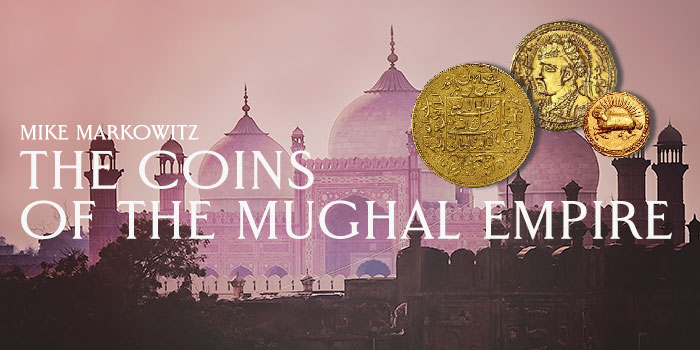
By Mike Markowitz for CoinWeek …..
The Mughal (or “Moghul“[1]) Empire ruled much of South Asia for over three centuries. Mughal emperors accumulated vast wealth, with an economy based on a stable and abundant coinage in gold, silver and copper. They commissioned magnificent buildings and works of art – including some of the largest, costliest, most beautiful and most historic coins ever issued.
Babur
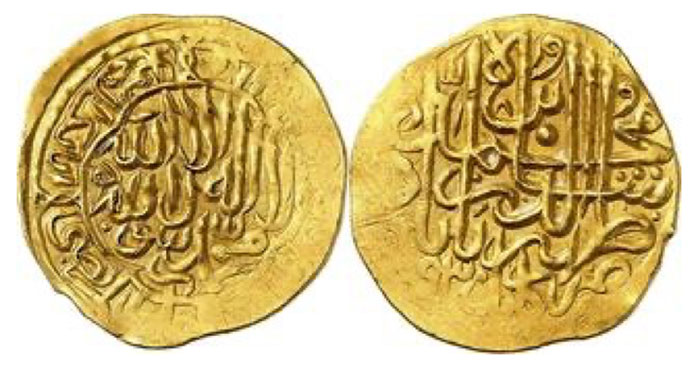
Zahir-ud-Din Muhammad, known as Babur (“Tiger” in Persian) was born a prince in 1483 in Ferghana (now in Uzbekistan), a fertile mountain valley famed for superb horses. He was a descendent of Timur (“Tamerlane”) on his father’s side and Jenghiz Khan on his mother’s side. At the age of 12, Babur became ruler of Ferghana. Two years later, he conquered the great central Asian trading city of Samarkand, only to lose it, as well as his own small kingdom, to more powerful warlords.
We know a great deal about Babur’s life because he wrote a remarkably candid and richly detailed autobiography, the Baburnama. The two-volume English translation by Beveridge (1922) runs over 900 pages.
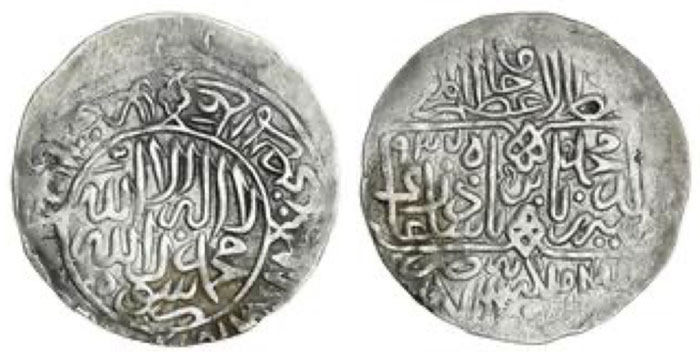
Babur’s early coinage was struck in Afghanistan. A unique mithqal or ashrafi (a gold piece of 4.7 grams) dated to AH 930 (about 1523 CE[2]) sold for over $120,000 USD in a recent Swiss auction.
In 1524, Babur invaded India, defeating the Sultan of Delhi in a great battle at Panipat[3] (April 21, 1526). From his new capital at Agra, Babur issued broad, thin silver coins of about 4.6 grams called shahrukhi[4] (named for Shah Rukh ruler of a central Asian empire who first issued them).
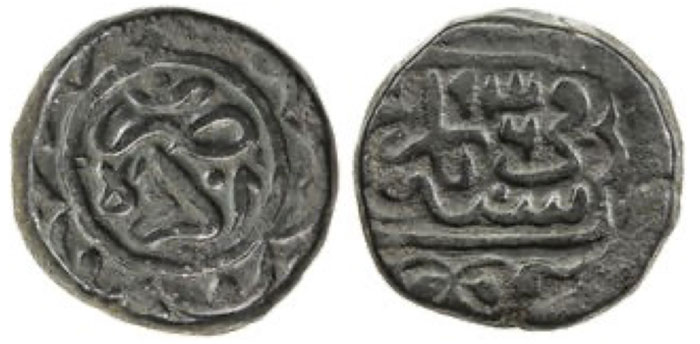
When Babur died in 1530 he left Delhi to his eldest son Humayun, age 22, and Kabul to his son Kamran Mirza, age 21. These half brothers would become bitter rivals.
Humayun
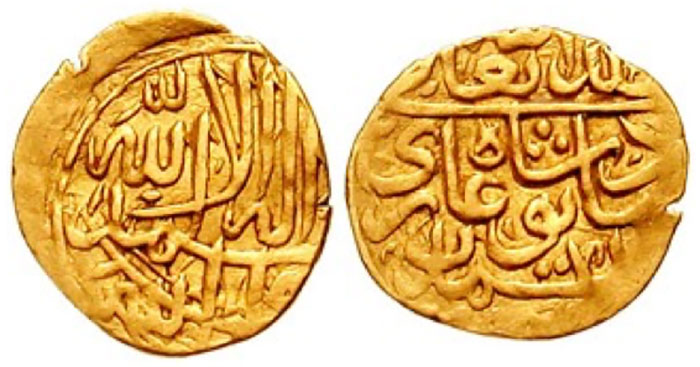
After ruling for 10 years, Humayun was betrayed by most of his brothers, defeated and driven from the throne by Sher Shah Suri, an Afghan warlord who established an extensive but short-lived empire (1540-1556.) Humayun fled to Persia, finding refuge at the brilliant court of Shah Tamasp I (ruled 1524-1576). To please his host, he converted from Sunni to Shi’a Islam. In 1555, with Persian help, Humayun reconquered Delhi.
The Suri Empire left Humayun a reformed and largely standardized coinage, consisting of the gold mohur (about 11 grams), the silver rupee[5] (about 11.5 grams), and the copper dam or paisa (of variable weight). One mohur typically traded for 15 rupees, and one rupee exchanged for 48 dam, but the market value of gold, silver and copper fluctuated freely.
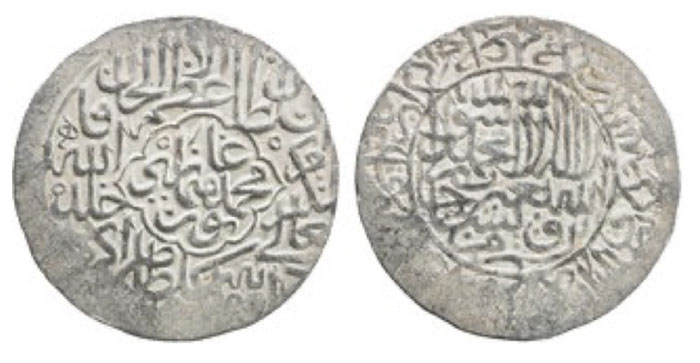
Humayun’s coins resemble his father Babur’s, but Humayun issued tiny gold fractions, as small as 1/12 mohur (0.84 grams)[6]. Lahore and Agra were major mints, although many coins bear no mint names. Along with the relatively common 4.7 gram silver shahrukhi[7], Humayun issued rare silver rupees in the eastern region of Bengal on a heavy 10- to 11-gram standard[8].

On January 24, 1556, Humayun was gravely injured falling down a staircase while descending from his library with his arms full of books, dying three days later. His magnificent tomb[9] still stands in Delhi.
Akbar
Jalal-ud-din Muhammad Akbar was just 14 years old when he came to the throne. His guardian, Bairam Khan, commander of the Mughal army, served as regent until Akbar came of age. Lavishly equipped with artillery and matchlock muskets, Akbar’s army conquered much of the subcontinent during a reign of almost 50 years.

Ruling an empire with a great diversity of faiths, languages and cultures, Akbar was remarkably tolerant, eventually abandoning orthodox Islam as the state religion. On coins, beginning in 1584 he recorded the date in terms of his regnal year rather than the Islamic calendar, and he replaced the Shahada[10] (Muslim profession of faith) with an Arabic phrase most religions could accept: “God is great, glorified be His glory” (Allah akbar, jalla jalalahu; Plant, 114). He abolished the discriminatory tax imposed on non-Muslims, and welcomed scholars, clerics, artists and poets of many religions and cultures to his court.
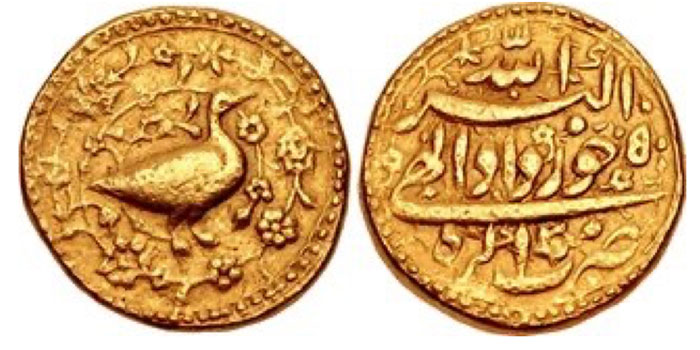
His abundant silver rupees occur in both round and square formats[13]. Perhaps the most surprising coin of this extraordinary ruler is one issued in Akbar’s final year that depicts full-length figures of the Hindu deities Rama[14] and Sita. The third known example brought $140,000 in a 2010 New York auction[15].

Akbar’s copper coinage includes fractions, such as the falus (about 4.4 grams), indicating a vibrant urban economy in which people need to make small daily purchases. Examples are usually heavily worn and those with complete inscriptions bring strong prices[16].
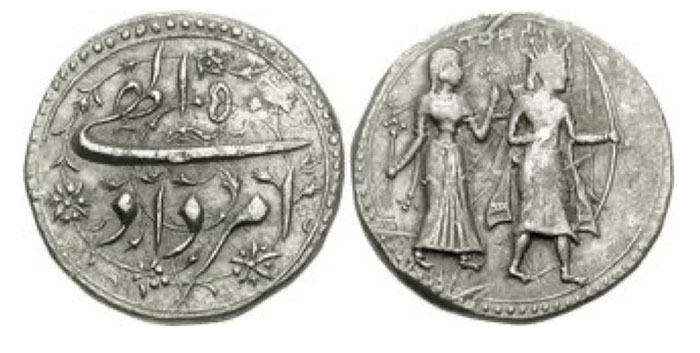
Akbar died on October 27, 1605. His tomb at Agra[17], built by his son Jahangir, is a masterpiece of Mughal architecture. The British Museum catalogue of Mughal coins succinctly explains why Akbar deserved the epithet “Great”:
“[T]he proof of the soundness of his system is the continuance of the Moghul Empire after his death, in spite of the follies and vices of his successors (Lane-Poole, xiv).”
Jahangir
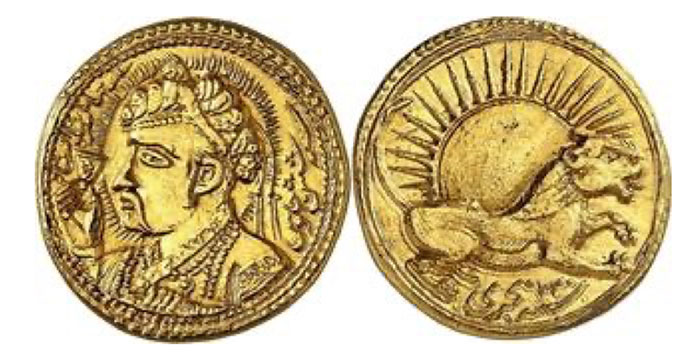
His given name was Nur-ud-Din Muhammad Salim, but he adopted the imperial name Jahangir, which means “world-grasper” in Persian. Jahangir came to the throne in 1605 at the age of 36 and ruled for 22 years. A great patron of art, architecture and literature, he took an interest in the exotic paintings and tapestries brought as gifts by European ambassadors to his court.
He issued what must have been the largest gold coin created before modern times, a 1,000-mohur presentation piece weighing nearly 12 kilograms. Offered for sale in a 1987 Swiss auction, it failed to find a buyer, and has apparently not surfaced since then; the Indian government reportedly suspected it was a stolen national treasure[18].

Jahangir’s best-known, most avidly collected coins are the “Zodiac” series in gold and silver depicting the 12 astrological signs. In his autobiography, he explains how he got the idea:
Previously to this, the rule of the coinage was that on the face of the metal they stamped my name, and on the reverse the name of the place and the year of the reign. At this time it entered my mind that in place of the month they should substitute the figure of the constellation which belonged to that month … in each month that was struck, the figure of the constellation was to be on one face, as if the sun was emerging from it[20].
A gold mohur depicting Aries the Ram brought $200,000 in a recent New York auction[21]. Due to the popularity of these coins, there are many replicas, forgeries and imitations, some created just a few decades after Jahangir’s death.
Jahangir’s silver rupees, from many different mints, are conventional and fairly inexpensive[22], with Persian verse inscriptions–the British cataloguer Lane-Poole calls them “jingles” (lxviii) in swooping elegant calligraphy on both sides. Some bear the name of his beloved empress, Nur Jahan. His heavy copper dams (20+ grams) are found mostly in Indian auctions where VF examples can be found for the equivalent of about $50[23].
Addicted to opium and a heavy drinker, Jahangir died 28 October 1627, aged 58. His splendid tomb still stands in Lahore[24].
Shah Jahan
Builder of the Taj Mahal, Shah Jahan is the best-known Mughal emperor.

His birth name was Shahab-ud-Din Muhammad Khurram. His boastful regnal title Shah Jahan means “World Emperor”. He had his elder brother Khusraw strangled in 1622 and killed off numerous rival royal princes. The Mughal game of thrones was a full-contact sport. He led a three-year revolt against his father in 1623, but was forgiven when he surrendered.
Shah Jahan’s 30-year reign (1628-1658) was truly a golden age. The British Museum has a replica of a 200-mohur gold presentation piece made in 1654; the original disappeared in the 1840s, probably melted down[25]. It is a mystery how such enormous blanks (diameter 131 mm, estimated weight 2177 grams, or almost 70 ounces) were struck without a modern hydraulic press.
His regular coinage abandoned the pictorial extravagance of his father’s issues, returning to the orthodox, purely calligraphic designs. Around 1977 a large hoard of uncirculated gold mohurs minted at the important trading port of Surat appeared on the market[26].
Fractional silver rupees were issued, but these seem to be rather rare. Some bear the word nisar (“scattering”), meaning they were thrown to the crowd on festive occasions. A nisar quarter rupee from a famous collection brought $800 against a $300 estimate in a 2017 US auction[27].
When Shah Jahan became ill in 1657, a succession struggle broke out among his four sons. His third son, Aurangzeb, held the ailing emperor prisoner until Shah Jahan died in 1666. His tomb is beside that of his beloved wife in the Taj Mahal.
“The coins of Akbar and of his successors, Jahangir and Shah-Jahan, are splendid specimens of the moneyer’s art. They may be compared advantageously in respect of execution and uniformity of standard with any contemporary European money… (Lane-Poole, lxvi)”
Shah Shuja
Shah Jahan’s third son, Shah Shuja[28], was governor of Bengal when his father died. Shah Shuja proclaimed himself emperor, and issued very rare silver rupees[29]. Defeated in battle by his brother Aurangzeb, Shuja died in exile a few years later.
Aurangzeb
Muhi-ud-Din Muhammad Aurangzeb Alamgir is remembered in Indian history as a fanatical Muslim who persecuted Hindus, Sikhs and others. His mother was Mumtaz Mahal (died 1631, aged 38), for whom the Taj Mahal was built.
He reigned for a remarkable 49 years (1658-1707), much of which was spent in campaigns to conquer the Hindu kingdoms of the southern part of the subcontinent. Aurangzeb eventually ruled an empire with an estimated 158 million subjects and the richest economy in the world.
Aurangzeb felt that verses from The Quran should not be stamped on coins, as done in former times, because they were constantly touched by the hands and feet of people. His coins had the name of the mint city and the year of issue on one face, and, the following couplet on other:
King Aurangzib ‘Ālamgir
Stamped coins, in the world, like the bright full moon[30]
Aurangzeb’s coins in gold, silver, and copper are mostly common. When he died at the age of 88, he left orders that he be buried in a plain, unmarked grave[31]. Under his successors the empire entered a long period of decline. In 1717, the British East India Company began striking coins at Bombay (now Mumbai) in the Mughal emperor’s name. After the Indian Rebellion (1857-58) the last Mughal emperor, Bahadur Shah Zafar[32], was deposed by the British and died in exile.
* * *
Notes
[1] “Mughal” is the preferred spelling in modern scholarship. The word derives from the Persian pronunciation of “Mongol”. In English, “mogul” has come to mean “an important or powerful person, especially in the motion picture industry.”
[2] The Islamic calendar (“AH”) uses a year of 12 lunar months (354 or 355 days), AH dates can fall in two different CE years: https://en.wikipedia.org/wiki/Islamic_calendar
[3] https://en.wikipedia.org/wiki/First_Battle_of_Panipat
[4] Spink Auction 18006, 25 September 2018, Lot 1228, realized £160 ($211) estimate £80 – 100
[5] https://en.wikipedia.org/wiki/History_of_the_rupee
[6] CNG Auction 64. 24 September 2003, Lot 1498, realized $850 (estimate $200)
[7] Stephen Album Auction 46, 23 January 2020, Lot 1186, realized $190 (estimate $100-130)
[8] CNG Auction 66, 19 May 2004, Lot 1877, realized $1300 (estimate $750)
[9] https://en.wikipedia.org/wiki/Humayun%27s_Tomb
[10] https://en.wikipedia.org/wiki/Shahada
[11] Numismatica Genevensis Auction 11 18 November 2019, Lot 23, realized CHF 550,000 ($556,906) estimate CHF 500,000
[12] CNG Triton XIX, 5 January 2016, Lot 2395, realized $170,000 (estimate $5000)
[13] Baldwin’s Auction 62/63
[14] https://en.wikipedia.org/wiki/Rama
[15] CNG Triton XIII, 5 January 2010, Lot 2001, realized $140,000 (estimate $75,000)
[16] Stephen Album Auction 18, 16 January 2014, Lot 1071, realized $500 (estimate $100-120)
[17] https://en.wikipedia.org/wiki/Akbar%27s_tomb
[19] Numismatica Genevensis Auction 11, 18 November 2019, Lot 30, realized CHF 150,000 ($151,883) estimate CHF 100,000
[20] Memoirs of Jahangir [Tuzk-e Jahangiri] Entry for 20 March 1619
[21] CNG Triton XXII, 8 January 2019, Lot 1260, realized $200,000 (estimate $150,000)
[22] Baldwin’s Auction 45, 3 May 2006, Lot 1056, realized £120 ($221) estimate £80-100
[23] Todywalla Auction 59, 7 January 2012, Lot 30, realized ₹2750 ($56)
[24] https://en.wikipedia.org/wiki/Tomb_of_Jahangir
[25] British Museum OR.7584
[26] CNG Triton XXIII, 14 January 2020, Lot 961, realized $2000 (estimate $2500)
[27] CNG Electronic Auction 389, 18 January 2017, Lot 1014 realized $800 (estimate $300)
[28] Not to be confused with the similarly named Afghan king, Shah Shujah Durrani, who died in 1842.
[29] Stephen Album Auction 23, 10 September 2015, Lot 1494, realized $15,000 (estimate $6-8,000 )
[30] https://en.wikipedia.org/wiki/Aurangzeb#Coins
[31] https://en.wikipedia.org/wiki/Tomb_of_Aurangzeb
[32] https://en.wikipedia.org/wiki/Bahadur_Shah_Zafar
References
Album, Stephen. Checklist of Islamic Coins, 3rd edition. Santa Rosa, CA (2011)
Awde, Nicholas and Putros Samano. The Arabic Alphabet. Secaucus, NJ (1998)
Beveridge, Annette (translator). The Babur-nama in English (Memoirs of Babur). London (1922)
Coin Study Circle. Collector’s Guide to Mughal Coins and Mints. Calcutta (1989)
Davies, C. Collin. An Historical Atlas of the Indian Peninsula. Oxford (1949)
Friedberg, Robert. Gold Coins of the World (2nd Edition). New York (1965)
Lane-Poole, Stanley. Catalogue of the Indian Coins in the British Museum: The Moghul Emperors. London (1892)
Plant, Richard. Arabic Coins and How to Read Them. London (1980)
Roberts, J. M. History of the World. New York (1993)
Tandon, Pankaj. “Fifty Coins in 2500 Years: A Numismatic Walk Through Indian History – Part II”, The Celator 24:8 (2010)
Thackston, Wheeler M (translator). The Jahangirnama: Memoirs of Jahangir, Emperor of India. Oxford (1999)
Truschke, Audrey. Aurangzeb: The Man and the Myth. Gurgaon, India (2017)





I have a coin. It’s like mughal empire coin.